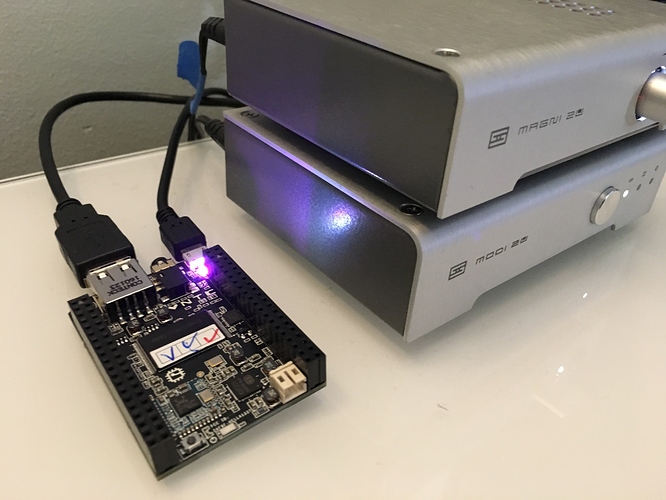I have seen a few threads discussing very low cost Roon Bridge endpoints and I thought I would add another to the mix. This weekend I was experimenting with Next Thing Co’s C.H.I.P, which is a $9 single board Linux computer running on an Allwinner R8 chip. Unlike the Raspberry Pi 2/3 (RPi), this machine comes with 4GB of storage and the OS is preinstalled. A power supply for the CHIP will likely cost you more than the board.
After playing around with a CHIP and an RPi3 as Roon Bridges this weekend, I found the CHIP easier to deal with, faster to get up and running, faster built-in wifi, smaller, and about 1/4 the price of the RPi. I have been listening to it all day without any real issues (which is more than I can say for the RPi3).
To get setup, you need a USB keyboard and a monitor with composite video (RCA) in, or alternatively you can purchase an HDMI adapter. If you are a little geeky, you can also use a standard issue USB to TTL Serial cable like this one: ttps://www.amazon.com/gp/product/B00QT7LQ88. I was unable to get the composite video working so from a Mac, I used a USB to serial cable to jack in with a command like
sudo cu -l /dev/tty.usbmodem2411 -s 115200
Instructions for headless login are here: http://docs.getchip.com/chip.html#headless-chip. The tutorial suggests using screen and installing some drivers, but I am happy to say that if you are on a mac, no drivers will be needed, and you can use cu for a more reliable serial operation. But I digress.
I am listening primarily to TIDAL and 16/44 FLAC files, but this setup had zero problems playing my 24/96 files - so RAM, and wifi IO are totally sufficient. In fact, the Roon process hovers between 6% and 9% CPU and about 5% RAM for these higher rez files. This is TONS of overhead!
I also found that the board can handle the USB soundcard getting disconnected (from a poweroff) and reconnected. Roon picks it up just fine.
The only quirk I have run up against so far is that if you shutdown the CHIP, it looses the enabled USB soundcard - I tested with a Schiit Modi 2. I am troubleshooting this half-heartedly - its not a dealbreaker for me. I’ll report back if I get this solved. The other thing to keep in mind is that if you encase the CHIP in metal, it may affect the wifi signal. That aforementioned RPi3 I am working with was in a nice aluminum case that did a splendid job of destabilizing the wifi and slowing it to a crawl. I assume similar could happen with the CHIP due to its tiny wifi antenna.
Summary: The CHIP is super cheap, available, easy to setup, and works great as a stable Roon Bridge endpoint. Oh, and a full kit with power supply comes out to about $25 delivered - less than 1/2 the price of a similar RPi3 getup.
Heres a pic. Why not.
